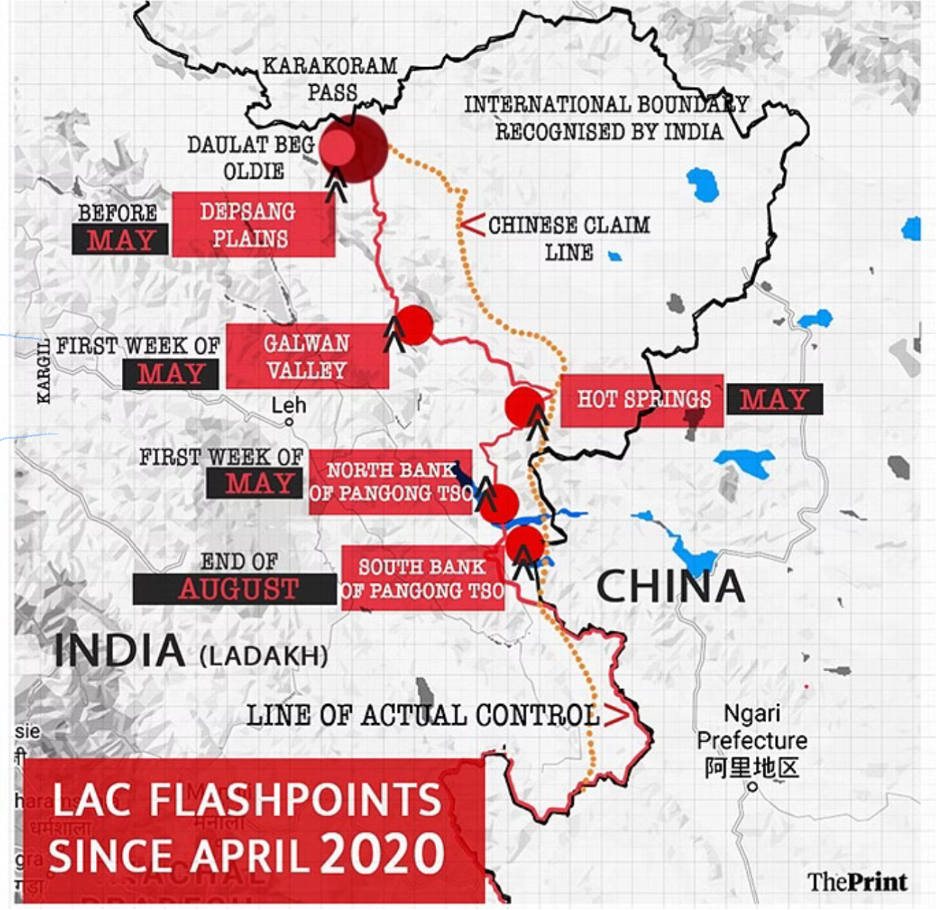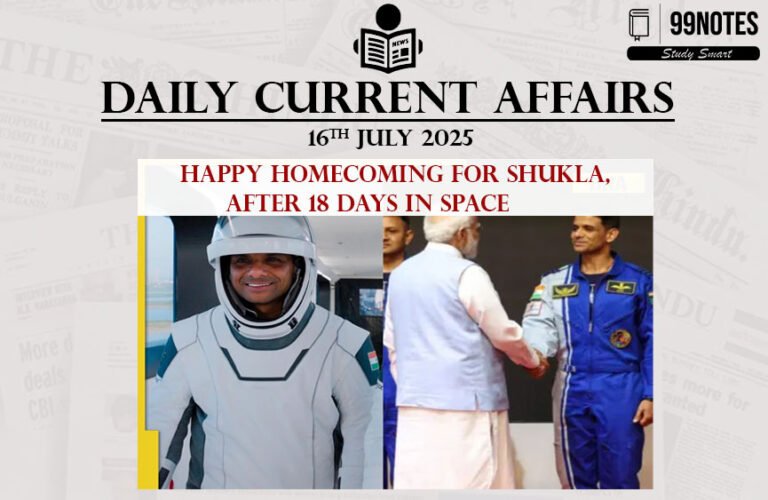25 August 2023 : Daily Current Affairs
Daily Current Affairs
- Daily Current Affairs
- 1. Should the CJI be part of the committee selecting the CEC?
- 2. India and the Northern Sea Route
- 3. Means used must be consistent with the ends achieved: CJI on dissolution of Article 370
- 4. BRICS now a non-Western grouping with the induction of six more member nations.
- 5. Indo-China Talks:
- Topic: GS2-IR
- Context:
- Details:
- Efforts being made to ease tensions:
- 6. Spotlight on pullback plan
- Topic: GS2-IR, Geography
- Context:
- Details:
- Depsang and Demchok: The two Friction points
- Depsang Plains
- Demchok:
- 7. Rover takes walk on Moon
- Topic: GS3-Science and Tech
- Context:
- Details:
- Rover and Lander Module:
- 8. India’s first carbon negative garrison or military formation.
- Context:
- About CME:
- What is Carbon Negative?
- Projects undertaken:
- 7-MW solar powerplant:
- How it has been helpful?
- 9. Taiwan to spend $3 billion on new weapons, gets F-16 boost
- Topic: Defense-Prelims
- Context:
- Details:
- 10. ICMR Covid study: key findings on mortality rate, comorbidities
- Context:
- What are its major findings?
- Who was at higher risk of mortality?
- Should those at risk of severe disease take precaution doses?
- For Enquiry
25-August-2023
Daily Current Affairs For UPSC ,Daily Current affairs of The hIndu and Indian Express.
1. Should the CJI be part of the committee selecting the CEC?
Topic: GS2 – Indian polity.
Context:
- The Union government introduced a Bill in the Rajya Sabha proposing changes to the selection panel for appointing the Election Commission (EC) members.
More information about the news:
- The proposed selection panel consists of the Prime Minister (chairperson), Leader of the Opposition (member), and a Union Cabinet Minister nominated by the Prime Minister (member).
- The Supreme Court had earlier directed the composition of the selection panel to include the Prime Minister, Leader of the Opposition, and the Chief Justice of India (CJI) until a law is enacted.
- The Bill has led to concerns about the neutrality of the panel due to the presence of two ruling dispensation members.
- Critics argue that while the Bill follows the letter of the Court’s judgment, it does not adhere to the spirit of the decision.
- Debate focuses on whether the CJI should be a part of the committee nominating the Chief Election Commissioner (CEC).
- The Chief Election Commissioner and Other Election Commissioners (Appointment, Conditions of Service and Term of Office) Bill, 2023, has sparked discussions about the potential impact on the Election Commission’s independence.
- The Bill also addresses issues related to CEC’s salary and the removal procedure for ECs.
- The current system of executive appointments and bureaucracy-driven appointments for ECs is debated for its potential influence on the independence of the Election Commission.
- Views differ on the Bill’s potential to override the Supreme Court ruling of March.
- The issue of CEC’s tenure and full tenure for the CEC is also being discussed.
2. India and the Northern Sea Route
Topic: GS3 – economy
Why is the Arctic region significant to India?
- The vulnerability of the Arctic region to climate change may have an impact on India in terms of economic security, water security and sustainability.
- The region constitutes the largest unexplored prospective area for hydrocarbons remaining on the Earth.
How old is India’s engagement with the Arctic?
- India’s engagement with the Arctic can be traced to the signing of the Svalbard Treaty in February 1920 in Paris.
- India is undertaking several scientific studies and research in the Arctic region.
- In May 2013, India became an observer-State of the Arctic Council
What is NSR?
- The Northern Sea Route (NSR), the shortest shipping route for freight transportation between Europe and countries of the Asia-Pacific region.
- Running to 5,600 km, the route begins at the boundary between the Barents and the Kara seas (Kara Strait) and ends in the Bering Strait (Provideniya Bay).
- The 2021 blockage of the Suez Canal has led to greater attention on the NSR.
How is Russia making the NSR navigable?
- Russia is the only country in the world with a nuclear-powered icebreaker fleet.
- The fleet comprises seven nuclear-powered icebreakers, apart from one nuclear container ship.
- Three more are expected to be commissioned between 2024 and 2027.
What are the driving factors for India to participate in the NSR development ?
- The growth in cargo traffic along the NSR is on the constant rise.
- With India increasingly importing crude oil and coal from Russia, the NSR assumes importance.
- The Chennai-Vladivostok Maritime Corridor (CVMC) project is being examined as one linking with another organise international container transit through the NSR.
- Experts are discussing the possibility of China and Russia gaining collective influence over the NSR.
Mains question: Discuss the significance of the Northern Sea Route (NSR) for India and its implications for India’s Arctic policy.
3. Means used must be consistent with the ends achieved: CJI on dissolution of Article 370
Topic: GS2 – Indian polity.
Context:
- CJI says ends can’t justify means in Article 370 case
- Govt says J&K lost sovereignty by signing Instrument of Accession
- J&K not special, says Centre
- Dissolution cured ‘psychological duality’ in minds of J&K people
Key points about the news:
- Chief Justice of India D.Y. Chandrachud said the government cannot justify the “means” used to dissolve Article 370 from the Constitution and erase Jammu and Kashmir as a full-fledged State in August 2019 by simply pointing to the “ends” achieved.
- The government began its response in the Article 370 case taking turns to convince the court that the dissolution was not a “fraud on the Constitution”.
- The government argued that Jammu and Kashmir had lost all traces of sovereignty the moment it signed the Instrument of Accession with the Government of India in October 1947.
- Mehta said Jammu and Kashmir could not be considered “special” or “unique” merely because it had a Constitution in 1939 or the Instrument of Accession had mentioned certain reservations interpreted as a continuation of the State’s internal sovereignty.
- The Solicitor-General said the petitioners had confused internal sovereignty with autonomy. “In a federal set-up, autonomy resides in every unit, in every State or institution. But that does not mean they have internal sovereignty,” Mr. Mehta argued.
4. BRICS now a non-Western grouping with the induction of six more member nations.
Topic: GS2 – International relations.
Context:
- BRICS has expanded its membership from five to 11 countries, strengthening its global position and political relevance.
More about the news:
- The expansion includes four major players from the West Asian region: Egypt, Iran, Saudi Arabia, and the UAE, as well as Ethiopia and Argentina from Africa and South America.
- The expansion sends a message that BRICS is an attractive club for members of the Global South, despite skepticism from the West.
- The expansion took place despite Western attempts to isolate Russia over its actions in Ukraine.
- India played a leading role in drafting the membership criteria and most new members are India’s strategic partners.
- Iran’s inclusion in BRICS opposes U.S. sanctions, reflecting its induction in the SCO as well.
- The new members have close economic ties to China, potentially impacting India’s influence within BRICS.
- The expansion supports India’s push for UN reform, increased representation of the Global South, and expansion of the UN Security Council.
5. Indo-China Talks:
Topic: GS2-IR
Context:
- In a major breakthrough in efforts to reduce tensions between the two countries over the military standoff in eastern Ladakh since May 2020, Prime Minister Narendra Modi conveyed India’s concerns to Chinese President Xi Jinping on “unresolved issues” along the Line of Actual Control, and the two leaders “agreed” to “direct their relevant officials to intensify efforts at expeditious disengagement and de-escalation” of troops on the ground.
Details:
- Prime Minister (Modi) highlighted India’s concerns on the unresolved issues along the LAC in the western sector of the India-China border area.
- The Prime Minister underlined that maintenance of peace and tranquillity in the border areas and observing and respecting the LAC are essential for the normalisation of the India-China relationship.
- In this regard, the two leaders agreed to direct their relevant officials to intensify efforts at expeditious disengagement and de-escalation.
Efforts being made to ease tensions:
- In recent days, commanders of the two countries have held a series of talks to resolve issues relating to the military standoff. Since mid-July, the two sides have had a series of conversations at multiple levels — between their Foreign Ministers, National Security Advisors, Corps Commanders, Major Generals and other commanders on the ground.
6. Spotlight on pullback plan
Topic: GS2-IR, Geography
Context:
- With prime minister Narendra Modi and Chinese President Xi Jinping agreeing to intensify efforts for expeditious disengagement and de-escalation along the Line of Actual Control (LAC) in eastern Ladakh, the spotlight is now on the exact contours of plans being drawn up by military commanders on the ground to pullback troops.
Details:
- The extent of disengagement and where on the LAC it will take place is not immediately clear. As per sources while clear orders are awaited, various modalities have been prepared for possible limited disengagement in phases.
- Commanders on the ground have been discussing possible scenarios for limited disengagement at certain mutually-accepted points along the boundary after the 19th round of India-China military talks earlier this month.
- Since 2020, Corps Commanders of India and China have been discussing resolution of the flashpoints along the LAC, including those which emerged after the standoff began.
- The talks led to some forward movement with both sides deciding to pull back troops – and dismantle temporary structures – from the Galwan Valley, the north and south banks of Pangong Tso and Patrolling Points in the Gogra and Hot Springs area.
- The last such movement was in September 2023 when both armies disengaged from PP-15 in the Gogra-Hot Springs area after multiple rounds of talks.
Depsang and Demchok: The two Friction points
Depsang Plains
- The legacy issues of Depsang Plains and Demchok – which predate the 2020 incursions by the Chinese PLA–continue to fester.
- At the Depsang Plains, Chinese troops have been blocking Indian access to PPs 10 to13 from a bottleneck known as the Y-junction as well as the 972 sq km tract of land there.
- The Depsang Plains are located close to the strategically important Daulat Beg Oldie.
- The Depsang Plains issue began in 2013 when China carried out an 18-km incursion in the area.
- Despite the two countries agreeing then to go back from their positions, the PLA troops did not vacate the area completely.
- India has since deployed a separate brigade to look after the area.
Demchok:
- In Demchok, which is in the southern part of eastern Ladakh, the problem is mainly at the Charding Ninglung Nullah (CNN) junction.
- In multiple instances, the PLA also stopped Indian graziers at the Saddle Pass at the CNN junction, well within India’s perception of the LAC.
7. Rover takes walk on Moon
Topic: GS3-Science and Tech
Context:
- A Day after the historic lunar landing by Chandrayaan-3, instruments on board the spacecraft began working and the rover took a “walk” on the Moon.
Details:
- Communication links between the lander and the rover have been established and the first images of the rover have been captured.
- ISRO released a video, taken by the Horizontal Velocity Camera on the lander, showing the last two minutes of the descent, just ahead of the touch down on Wednesday evening.
- As per the statement released by ISRO, all activities were on schedule and all systems were normal.
- Lander module payloads ILSA, RAMBHA and ChaSTE were turned On.
- Rover mobility operations also commenced.
- SHAPE payload on the propulsion module was turned ON.
Rover and Lander Module:
- Establishment of communication links between the rover and the lander is a key step in transmitting data gathered by the instruments, between the two of them, and with the ground stations on Earth.
- The rover module carries two scientific instruments –the Alpha Particle X-ray Spectrometer to study the elements present on the surface, and the Laser Induced Breakdown Spectroscope which uses a different method to analyse the chemical makeup.
8. India’s first carbon negative garrison or military formation.
Context:
- Pune-based college of military engineering (CME) said that with the commissioning of a 5-megawatt (MW) solar power plant, taking its solar power generation capacity to 7 MW, it has become India’s first carbon negative garrison or military formation.
About CME:
- The CME, which was established in 1948 as a premier institute of the armed forces, trains all ranks of Indian Army, Navy and Air force, including those from friendly foreign countries in various technical and tactical aspects with changing character of warfare.
What is Carbon Negative?
- The carbon negative refers to an entity emitting less than zero carbon dioxide and carbon dioxide equivalent (CO2e) greenhouse gasses, effectively.
- Emitting a negative amount of carbon being carbon negative refers to the net emissions of the entity by offsetting more carbon, through processes like carbon capture, sequestration and avoidance, than the entity contributes to the environment.
Projects undertaken:
- A plethora of projects has been undertaken in the recent past at CME by the Military Engineering Services (MES) through the office of Garrison Engineer (CME), Khadki, in order to reduce the institute’s carbon footprint.
- The biggest project is implementation of the7-MW solar powerplant in CME in two phases, apart from multiple important pilot projects such as solar steam cooking plants for community cooking for troops at CME and installation of Retrofitting Emission Control Devices (RECDs) on diesel generator sets to curb emissions.
7-MW solar powerplant:
- The first phase of the 7-MW solar powerplant was undertaken with the commissioning of a 2-MW solar power plant in 2021 fulfilling the day time energy requirements of the CME.
- The commissioning of the 5-MW plant in the second phase has been key in achieving the objective of ‘National Solar Mission’ under Government of India.
- Success of the project has paved the way for other formations and tri-services establishments to become carbon negative in the future.
How it has been helpful?
- Apart from annual fiscal savings of Rs 6.5 crore to the national exchequer, the 5- MW plant connected to the Maharashtra State Electricity Grid makes it possible for the power generated at CME to be consumed at National Defence Academy at Khadakwasla, Command Hospital Pune, Military Hospital Khadki and Bombay Engineer Group and Centre, Khadki, spread across the city of Pune, thus further ensuring achieving of ‘National Clean Air Programme’ by reducing dependency on conventional thermal powerplants.
- With commissioning of a 5- MW solar power plant, the CME has become a completely carbon negative garrison—a first in India which is an impressive feat.
9. Taiwan to spend $3 billion on new weapons, gets F-16 boost
Topic: Defense-Prelims
Context:
- Taiwan will spend an extra T$94.3 billion ($2.97 billion) to buy weapons next year including fighter jets to bolster its defences against China and will get a further boost from new F16 fighter jet tracking systems.
Details:
- Overall proposed defence spending for 2024 would be set at T$606.8 billion, a 3.5% increase from the previous year.
- About half of the T$94.3 billion additional spend would be used to purchase fighter jets, and the remainder will go into bolstering naval defences.
- The US approved a possible $500 million sale to Taiwan of infrared search and track systems for F-16 fighter jets, as well as other equipment.
- The search and tracking systems were the same as those used by F35 and F-22 fighters, among the most advanced which the US operates.
- These will help to target the J-20 stealth fighter which are the new generation of Chinese jets over the Taiwan Strait in the future.
10. ICMR Covid study: key findings on mortality rate, comorbidities
Context:
- A Study by the Indian Council of Medical Research published recently said that nearly 6.5% people hospitalized with Covid-19 died in the following year. This is comparable to data from across the world.
What are its major findings?
- The study is based on the data of 14,419 patients across 31 hospitals. It includes patients who were hospitalised since September 2020, meaning the infections are likely to have been caused by the original, delta, or omicron coronavirus variants.
- Besides, it looks at outcomes only in those who were hospitalized with moderate to severe disease.
- Apart from the findings mentioned above, the study found that 17.1% of the participants experienced post Covid-19 conditions such as lethargy and breathlessness, and cognitive abnormalities like brain fog and difficulty in concentrating.
- It also said that people were nearly three times more likely to die if they experienced these post Covid-19 conditions.
- The study put in a caveat that the exact definition of “post-Covid-19 conditions”, as given by World Health Organization or Centers for Disease Control and Prevention (CDC) could not be used, as they came out after patient enrolment had already begun.
- The study also showed that even a single dose of the vaccine before the infection reduced the number of deaths in the one-year period by 60%.
Who was at higher risk of mortality?
- The factors that increased the risk of death later in the year following a Covid-19 infection were comorbidity, age, and gender.
- The study found that people with one comorbid condition were more than 9 times likely to die during the year following the infection.
- Men were 1.3 times more likely to die and those above the age of 60years 2.6 times more likely to die, according to the data.
- Children between the ages of 0 and 18 years were at a 5.6 times higher risk of death between the first follow-up at four weeks and the follow-up at one-year mark. This risk was 1.7-fold in the four weeks immediately after hospitalisation, meaning that more children died later in the year.
- Comorbidities among admitted children are more severe, such as malignancies, kidney disorders, haematological disorders and others. This could be hypothesized as one of the reasons for the higher odds of death among these children.
- So, people with any comorbidities, especially conditions such as liver cirrhosis and chronic kidney disease, must take all precautions because they are likely to get severe disease and complications. They must stay in touch with their doctors and monitor their conditions well.”
Should those at risk of severe disease take precaution doses?
- At the moment there is no need to take additional doses of the vaccine as the disease remains mild, just upper respiratory symptoms such as cough and cold in most people.
For Enquiry

25 August 2023 : Daily Current Affairs

24 August 2023 : Daily Answer Writing

23 August 2023 : Daily Answer Writing

24 August 2023 : Daily Quiz

23 August 2023 : Daily Quiz

24 August 2023 : Indian Express

23 August 2023 : Indian Express

24 August 2023 : PIB

23 August 2023 : PIB

24 August 2023 : The Hindu Editorial Notes PDF
August Daily Current Affairs 25 August 2023 : Daily Current Affairs Daily Current Affairs
25-August-2023
Daily Current Affairs For UPSC ,Daily Current affairs of The hIndu…
mains answer writing 24 August 2023 : Daily Answer Writing Mains Answer Writing
One of the key components of these exams is the written test, which consists of…
mains answer writing 23 August 2023 : Daily Answer Writing Mains Answer Writing
One of the key components of these exams is the written test, which consists of…
Daily Quiz 24 August 2023 : Daily Quiz 24 August 2023 : Daily Quiz…
Daily Quiz 23 August 2023 : Daily Quiz 23 August 2023 : Daily Quiz…
August 2023 Indian Express 24 August 2023 : Indian Express Indian Express
24-August–2023
The Indian Express, CSE candidates can stay informed about current…
August 2023 Indian Express 23 August 2023 : Indian Express Indian Express
23-August–2023
The Indian Express, CSE candidates can stay informed about current…
August PIB 2023 24 August 2023 : PIB PRESS INFORMATION BUREAU
24-August -2023
Daily Current Affairs For UPSC ,The PIB ( Press Information…
August PIB 2023 23 August 2023 : PIB PRESS INFORMATION BUREAU
23-August -2023
Daily Current Affairs For UPSC ,The PIB ( Press Information…
August- The Hindu Editorial 24 August 2023 : The Hindu Editorial Notes PDF The Hindu Editorial
24-August-2023
Daily Current Affairs For UPSC ,The Hindu Editorial Summary
Facebook-f
Twitter
Youtube
1….




